A Cost Optimized Fully Sustainable Power System for Southeast Asia and the Pacific Rim
Abstract
:1. Introduction
2. Methodology
2.1. Summary of the Model
2.2. Input Data
- (1)
- The geothermal potential data for every sub-region is calculated based on the already available information on the surface heat flow rate [38,39] and the surface ambient temperature for the year 2005 globally. Extrapolation of the available heat flow data was performed for areas where surface heat flow data were not available. Based on these available data, different temperature levels and available heat at the mid-point of a 1 km thick deep layer, between the depths of 1 km to 10 km [40,41] globally with 0.45° × 0.45° spatial resolution are derived.
- (2)
- Industrial gas consumption data are based on IEA statistics for energy sector demand [42].
- (3)
- Projected water desalination demand was determined for every sub-region. Water desalination demand is calculated on projections for water consumption and water stress [43]. In the model, it is assumed that water stress of more than 50% will be covered by seawater desalination. The calculations for the technical constraints and financial cost of seawater reverse osmosis desalination are described in [44].
2.3. Applied Technologies
3. Scenario Assumptions
3.1. Subdivision of the Region and Grid Structure
3.2. Applied Scenarios
- (1)
- Region-wide open trade scenario, in which the regions are independent of each other and have no interconnections so the demand for electricity is covered by the respective regions’ own generation capacity.
- (2)
- Country-wide open trade scenario, in which there are interconnections with HVDC lines between the regions of the same country.
- (3)
- Area-wide open trade scenario, in which the energy systems of the countries are interconnected.
- (4)
- Integrated scenario: Area-wide scenario plus SWRO desalination and industrial gas demand, where PtG technology is used not only as a storage option but also covers industrial gas demand. This increases the flexibility of the system.
3.3. Financial and Technical Assumptions
3.4. Biomass and Geothermal Potentials
3.5. Feed-in for Solar and Wind Energy
3.6. Upper and Lower Limitations on Installed Capacities
3.7. Load
4. Results
5. Discussion
5.1. Discussion of Results
5.2. Comparision with Other Future Scneario Studies for Southeast Asia and Pacific Rim
5.3. Discussion of the LCOE of Alternative Technologies
6. Conclusions
Supplementary Materials
Acknowledgments
Author Contributions
Conflicts of Interest
Abbreviations
| A-CAES | Adiabatic compressed air energy storage |
| ASEAN | Association for South East Nations |
| Capex | Capital expenditure |
| CCGT | Combined cycle gas turbine |
| CCS | Carbon capture and storage |
| CSP | Concentrating solar thermal power |
| FLH | Full load hours |
| HVDC | High-voltage direct current |
| IEA | International Energy Agency |
| NEM | National Electricity Market |
| LCOC | Levelized cost of curtailment |
| LCOE | Levelized cost of electricity |
| LCOG | Levelized cost of gas |
| LCOS | Levelized cost of storage |
| LCOT | Levelized cost of transmission |
| OCGT | Open cycle gas turbine |
| Opex | Operational expenditure |
| PHS | Pumped hydro storage |
| PtG | Power-to-gas |
| RE | Renewable energy |
| SWRO | Seawater reverse osmosis |
| TES | Thermal energy storage |
| WACC | Weighted average cost of capital |
References
- Khare, V.; Nema, S.; Baredar, P. Status of solar wind renewable energy in India. Renew. Sustain. Energy Rev. 2013, 27, 1–10. [Google Scholar] [CrossRef]
- Cochran, J.; Miller, M.; Milligan, M.; Ela, E.; Arent, D.; Bloom, A. Market Evolution: Wholesale Electricity Market Design for 21st Century Power Systems; Technical Report, Contract No. DE-AC36-08GO28308; National Renewable Energy Laboratory: Golden, CO, USA, 2013.
- International Monetary Fund. World Economic Outlook Database; IMF: Washington, DC, USA, 2015. [Google Scholar]
- United Nations, Department of Economic and Social Affairs, Population Division. World Population Prospects: The 2015 Revision; United Nations: New York, NY, USA, 2015. [Google Scholar]
- International Energy Agency. Southeast Asia Energy Outlook; IEA Publications: Paris, France, 2015. [Google Scholar]
- Blakers, A.W.; Luther, J.; Nadolny, A. Asia Pacific Super Grid—Solar electricity generation, storage and distribution. Green 2012, 2, 189–202. [Google Scholar]
- Teske, S.; Pregger, T.; Simon, S.; Naegler, T.; O’Sullivan, M.; Sawyer, S.; Obusan, A.; Buakamsri, T. Energy [R]evolution: A Sustainable ASEAN Energy Outlook; Greenpeace International and European Renewable Energy Council (EREC): Amsterdam, The Netherlands, 2013. [Google Scholar]
- Garnaut, R. The Garnaut Review: Australia in the Global Response to Climate Change; Cambridge University Press: Cambridge, UK, 2011. [Google Scholar]
- Koh, S.L.; Lim, Y.S. Meeting energy demand in a developing economy without damaging the environment—A case study in Sabah, Malaysia, from technical, environmental and economic perspectives. Energy Policy 2010, 38, 4719–4728. [Google Scholar] [CrossRef]
- Mathiesen, B.V.; Lund, H.; Karlsson, K. 100% Renewable energy systems, climate mitigation and economic growth. Appl. Energy 2011, 88, 488–501. [Google Scholar] [CrossRef]
- Lund, H.; Mathiesen, B.V. Energy system analysis of 100% renewable energy systems—The case of Denmark in years 2030 and 2050. Energy 2009, 34, 524–531. [Google Scholar] [CrossRef]
- Yusaf, T.; Goh, S.; Borserio, J.A. Potential of renewable energy alternatives in Australia. Renew. Sustain. Energy Rev. 2011, 15, 2214–2221. [Google Scholar] [CrossRef]
- Taggart, S. A Pan-Asian Energy Infrastructure by 2050; Grenatec: Sydney, Australia, 2013. [Google Scholar]
- Mason, I.G.; Page, S.C.; Williamson, A.G. A 100% renewable electricity generation system for New Zealand utilising hydro, wind, geothermal and biomass resources. Energy Policy 2010, 38, 3973–3984. [Google Scholar] [CrossRef]
- Kelly, G. History and potential of renewable energy development in New Zealand. Renew. Sustain. Energy Rev. 2011, 15, 2501–2509. [Google Scholar] [CrossRef]
- Lidula, N.W.A.; Mithulananthan, N.; Ongsakul, W.; Widjaya, C.; Henson, R. ASEAN towards clean and sustainable energy: Potentials, utilization and barriers. Renew. Energy 2007, 32, 1441–1452. [Google Scholar] [CrossRef]
- Asian Development Bank. Rural Renewable Energy Initiative in the Greater Mekong Subregion; ADB: Manila, Philippines, 2015. [Google Scholar]
- Asian Development Bank. Business Models to Realize the Potential of Renewable Energy and Energy Efficiency in the Greater Mekong Subregion; ADB: Manila, Philippines, 2015. [Google Scholar]
- Elliston, B.; Diesendorf, M.; MacGill, I. Simulations of scenarios with 100% renewable electricity in the Australian National Electricity Market. Energy Policy 2012, 45, 606–613. [Google Scholar] [CrossRef]
- Matthew, W.; Patrick, H. Zero Carbon Australia Stationary Energy Plan; Melbourne Energy Institute: Melbourne, Australia, 2010. [Google Scholar]
- Elliston, B.; MacGill, I.; Diesendorf, M. Least cost 100% renewable electricity scenarios in the Australian National Electricity Market. Energy Policy 2013, 59, 270–282. [Google Scholar] [CrossRef]
- Taggart, B.S.; James, G.; Dong, Z.; Russell, C. The future of renewables linked by a transnational Asian grid. Proc. IEEE 2011, 100, 348–359. [Google Scholar] [CrossRef]
- Hearps, P.; Gilbert, S.C. An Energy Revolution is Possible; Friends of the Earth International: Amsterdam, The Netherlands, 2015. [Google Scholar]
- Huber, M.; Roger, A.; Hamacher, T. Optimizing long-term investments for a sustainable development of the ASEAN power system. Energy 2015, 88, 180–193. [Google Scholar] [CrossRef]
- Association of Southeast Nations. ASEAN Plan of Action for Energy Cooperation 2010–2015; ASEAN Centre for Energy Impact of Global Economic Crisis: Jakarta, Indonesia, 2012. [Google Scholar]
- Chang, Y.; Li, Y. Power generation and cross-border grid planning for the integrated ASEAN electricity market: A dynamic linear programming model. Energy Strateg. Rev. 2013, 2, 153–160. [Google Scholar] [CrossRef]
- Taggart, S. A grand vision for power in Asia. Renew. Energy Focus 2011, 12, 57–59. [Google Scholar] [CrossRef]
- Dii GmbH. Desert Power 2050: Perspectives on a Sustainable Power System for EUMENA; Dii GmbH: Munich, Germany, 2012. [Google Scholar]
- Desertec Foundation. Clean Power from Deserts—The DESERTEC Concept for Energy, Water and Climate Security; Desertec Foundation: Hamburg, Germany, 2007. [Google Scholar]
- International Energy Agency Photovoltaics Power Systems Programme. Energy from the Desert—Very Large Scale PV Power Plants for Shifting to Renewable Energy Future; Report IEA-PVPS; IEA-PVPS: St. Ursen, Switzerland, 2015. [Google Scholar]
- Mano, S.; Ovgor, B.; Samadov, Z.; Pudlik, M.; Julich, V.; Sokolov, D.; Yong Yoon, J. Gobitec and Asian Super Grid for Renewable Energies in Northeast Asia, Report Prepared by Energy Charter Secretariat; Energy Economics Institute of the Republic of Korea: Ulsan, Korea; Energy Systems Institute of the Russian Federation: Irkutsk, Russia; Ministry of Energy of Mongolia: Ulaanbaatar, Mongolia; Japan Renewable Energy Foundation: Tokyo, Japan, 2014.
- Komoto, K.; Enebish, N.; Song, J. Very large scale PV systems for North-East Asia: Preliminary project proposals for VLS-PV in the Mongolian Gobi desert. In Proceedings of the 39th Photovoltaic Specialists Conference (PVSC), Tampa, FL, USA, 16–21 June 2013. [Google Scholar]
- Mella, S. Does Australia Energy Export Future Lie with the Asian Supergrid? Available online: http://nautilus.org/napsnet/napsnet-policy-forum/does-australia-energy-export-future-lie-with-the-asian-supergrid/ (accessed on 1 February 2017).
- Baumann, C.; Schuster, R.; Moser, A. Economic potential of power-to-gas energy storages. In Proceedings of the 2013 10th International Conference on the European Energy Market (EEM), Stockholm, Sweden, 27–31 May 2013; pp. 1–6. [Google Scholar]
- Ibrahim, H.; Ilinca, A.; Perron, J. Energy storage systems-Characteristics and comparisons. Renew. Sustain. Energy Rev. 2008, 12, 1221–1250. [Google Scholar] [CrossRef]
- Breyer, C.; Tsupari, E.; Tikka, V.; Vainikka, P. Power-to-Gas as an emerging profitable business through creating an integrated value chain. Energy Procedia 2015, 73, 182–189. [Google Scholar] [CrossRef]
- Bogdanov, D.; Breyer, C. North-East Asian Super Grid for 100% Renewable Energy supply: Optimal mix of energy technologies for electricity, gas and heat supply options. Energy Convers. Manag. 2016, 112, 176–190. [Google Scholar] [CrossRef]
- International Association of Seismology and Physics of the Earth’s Interior. The International Heat Flow Commission; IHFC Database; IASPEI: Boulder, CO, USA, 2015. [Google Scholar]
- American Association of Petroleum Geologists. Global Heat Flow Database; American Association of Petroleum Geologists: Tulsa, OK, USA, 2015. [Google Scholar]
- Chamorro, C.R.; García-Cuesta, J.L.; Mondéjar, M.E.; Linares, M.M. An estimation of the enhanced geothermal systems potential for the Iberian Peninsula. Renew. Energy 2014, 66, 1–14. [Google Scholar] [CrossRef]
- Huenges, E. Geothermal Energy Systems, Exploration, Development and Utilization, 2nd ed.; John Wiley & Sons: Weinheim, Germany, 2012. [Google Scholar]
- International Energy Agency. Energy Balances of OECD Countries; IEA: Paris, France, 2013. [Google Scholar]
- Luck, M.; Landis, M.; Gassert, F. Aqueduct Water Stress Projections: Decadal Projections of Water Supply and Demand Using CMIP5 GCMs; World Resources Institute: Washington, DC, USA, 2015. [Google Scholar]
- Caldera, U.; Bogdanov, D.; Breyer, C. Local cost of seawater RO desalination based on solar PV and wind energy: A global estimate. Desalination 2016, 385, 207–216. [Google Scholar] [CrossRef]
- Barbosa, L.S.N.S.; Bogdanov, D.; Vainikka, P.; Breyer, C. Hydro, wind and solar power as a base for a 100% Renewable Energy supply for South and Central America. PLoS ONE 2017, 12, e0173820. [Google Scholar] [CrossRef] [PubMed]
- Perusahaan Listrik Negara. Towards New Performance Level; PLN: Jakarta, Indonesia, 2014. [Google Scholar]
- Blechinger, P.; Cader, C.; Bertheau, P.; Huyskens, H.; Seguin, R.; Breyer, C. Global Analysis of the Techno-Economic Potential of Renewable Energy Hybrid Systems on Small Islands. Energy Policy 2016, 98, 674–687. [Google Scholar] [CrossRef]
- Faizal, R.; Nurdin, M.; Hariyanto, N.; Pack, S.; Plesch, J. Sumatra-Java HVDC transmission system modelling and system impact analysis. In Proceedings of the IEEE PowerTech 2015, Eindhoven, The Netherlands, 29 June–2 July 2015; pp. 1–6. [Google Scholar]
- Pleßmann, G.; Erdmann, M.; Hlusiak, M.; Breyer, C. Global energy storage demand for a 100% renewable electricity supply. Energy Procedia 2014, 46, 22–31. [Google Scholar] [CrossRef]
- Agora Energiewende. Stromspeicher in der Energiewende. Agora Energiewende: Berlin, 2014. Available online: www.agora-energiewende.de/themen/optimierung/detailansicht/article/studie-die-energiewende-muss-nicht-auf-stromspeicher-warten/ (accessed on 1 February 2017).
- UBS. Q-Series—Global Utilities, Autos & Chemicals—Will Solar, Batteries and Electric Cars Re-Shape the Electricity System? UBS: Basel, Switzerland, 2014. [Google Scholar]
- Hoffmann, W. Importance and evidence for cost effective electricity storage. In Proceedings of the 29th European Photovoltaic Solar Energy Conference and Exhibition (EU PVSEC), Amsterdam, The Netherlands, 22–26 September 2014. [Google Scholar]
- Fraunhofer Institute for Solar Energy Systems. Current and Future Cost of Photovoltaics. Long-term Scenarios for Market Development, System Prices and LCOE of Utility-Scale PV Systems; Fraunhofer Institute for Solar Energy Systems: Freiburg, Germany, 2015. [Google Scholar]
- United Nations. World Urbanization Prospects, the 2014 Revision; UN: New York, NY, USA, 2014. [Google Scholar]
- Urban, W.; Lohmann, H.; Girod, K. Abschlussbericht fur das BMBF-Verbundprojekt Biogaseinspeisung. Fraunhofer UMSICHT, 2009. Available online: www.biogaseinspeisung.de/download/Abschlussbericht_Biogaseinspeisung_Band_4_Technik_Biogasaufbereitung_AP2.pdf (accessed on 1 February 2017). (In German).
- European Commission. ETRI 2014—Energy Technology Reference Indicator Projections for 2010–2050; EC Joint Research Centre Institute for Energy and Transport: Petten, The Netherlands, 2014. [Google Scholar]
- Gerlach, A.; Werner, C.; Breyer, C. Impact of financing costs on global grid-parity dynamics till 2030. In Proceedings of the 29th European Photovoltaic Solar Energy Conference and Exhibition (EU PVSEC), Amsterdam, The Netherlands, 22–26 September 2014. [Google Scholar]
- Werner, C.; Breyer, C.; Gerlach, A.; Beckel, O. Photovoltaic with energy storage: An overview on economics, system design and politics. In Proceedings of the 27th European Photovoltaic Solar Energy Conference (EU PVSEC), Frankfurt, Germany, 24–28 September 2012. [Google Scholar]
- German Biomass Research Centre. Regionale und Globale Räumliche Verteilung von Biomassepotenzialen; German Biomass Research Centre: Leipzig, Germany, 2009. (In German) [Google Scholar]
- International Energy Agency. Technology Roadmap—Bioenergy for Heat and Power; IEA Publications: Paris, France, 2012. [Google Scholar]
- Intergovernmental Panel on Climate Change. Special Report on RE Sources and CC Mitigation; Intergovernmental Panel on Climate Change: Geneva, Switzerland, 2011. [Google Scholar]
- Farfan, J.; Breyer, C. Structural Changes of the global power generation capacity towards sustainability and the risk of stranded investments supported by a sustainability indicator. J. Clean. Prod. 2017, 141, 370–384. [Google Scholar] [CrossRef]
- Gulagi, A.; Aghahosseini, A.; Bogdanov, D.; Breyer, C. Comparison of the potential role of adiabatic compressed air energy storage (A-CAES) for a fully sustainable energy system in a region of significant and low seasonal variations. In Proceedings of the 10th International Renewable Energy Storage Conference, Düsseldorf, Germany, 15–17 March 2016. [Google Scholar]
- Fthenakis, V.; Mason, J.E.; Zweibel, K. The technical, geographical, and economic feasibility for solar energy to supply the energy needs of the US. Energy Policy 2009, 37, 387–399. [Google Scholar] [CrossRef]
- Aghahosseini, A.; Breyer, C. Assessment of Adiabatic Compressed Air Energy Storage Geological Resource Potential for the Global Electricity Supply. Energy 2017. submitted. [Google Scholar]
- Gulagi, A.; Bogdanov, D.; Fasihi, M.; Breyer, C. Can Australia power the energy-hungry Asia with renewable energy? Sustainability 2017, 9, 233. [Google Scholar] [CrossRef]
- International Energy Agency. World Energy Outlook 2016; IEA Publications: Paris, France, 2016. [Google Scholar]
- Breyer, C. Comments on the IEA World Energy Outlook 2016. In Proceedings of the WEC Finland’s Breakfast Meeting: IEA World Energy Outlook 2016, Helsinki, Finland, 23 November 2016. [Google Scholar]
- Vartiainen, E.; Masson, G.; Breyer, C. PV LCOE in Europe 2015–2050. In Proceedings of the 31st European Photovoltaic Solar Energy Conference (EU PVSEC), Hamburg, Germany, 14–18 September 2015. [Google Scholar]
- Energy Watch Group. IEA Creates Misleading Future Scenarios for Solar Power Generation, Berlin. 27 November 2015. Available online: http://energywatchgroup.org/iea-creates-misleading-future-scenarios-solar-power-generation/ (accessed on 1 February 2017).
- Carbon Tracker. Lost in Transition: How the Energy Sector Is Missing Potential Demand Destruction; Carbon Tracker: London, UK, 2015. [Google Scholar]
- Liebreich, M. Future of Energy Summit; Bloomberg New Energy Finance: Shanghai, China, 2015. [Google Scholar]
- Metayer, M.; Breyer, C.; Fell, H.-J. The projections for the future and quality in the past of the World Energy Outlook for solar PV and other Renewable Energy technologies. In Proceedings of the 31st European Photovoltaic Solar Energy Conference (EU PVSEC), Hamburg, Germany, 14–18 September 2015. [Google Scholar]
- United Nations Framework Convention on Climate Change. Adoption of the Paris Agreement—Proposal by the President; UNFCCC: Paris, France, 2015. [Google Scholar]
- Afanasyeva, S.; Breyer, C.; Engelhard, M. Impact of battery cost on the economics of hybrid photovoltaic power plants. Energy Procedia 2016, 99, 157–173. [Google Scholar] [CrossRef]
- Agora Energiewende. Comparing the Cost of Low-Carbon Technologies: What Is the Cheapest Option? Agora Energiewende: Berlin, Germany, 2014. [Google Scholar]
- European Commission. Integration of Renewable Energy in Europe. Study Prepared by KEMA Consulting, DNV GL; Energy, Imperial College and NERA Economic Consulting on behalf of DG Energy: Brussels, Belgium, 2014; pp. 7–8, 54. [Google Scholar]
- Citi Research Equities. Paris Climate Change Agreement; Citi Research Equities: Sydney, Australia, 2015. [Google Scholar]
- Dittmar, M. Nuclear energy: Status and future limitations. Energy 2012, 37, 35–40. [Google Scholar] [CrossRef]
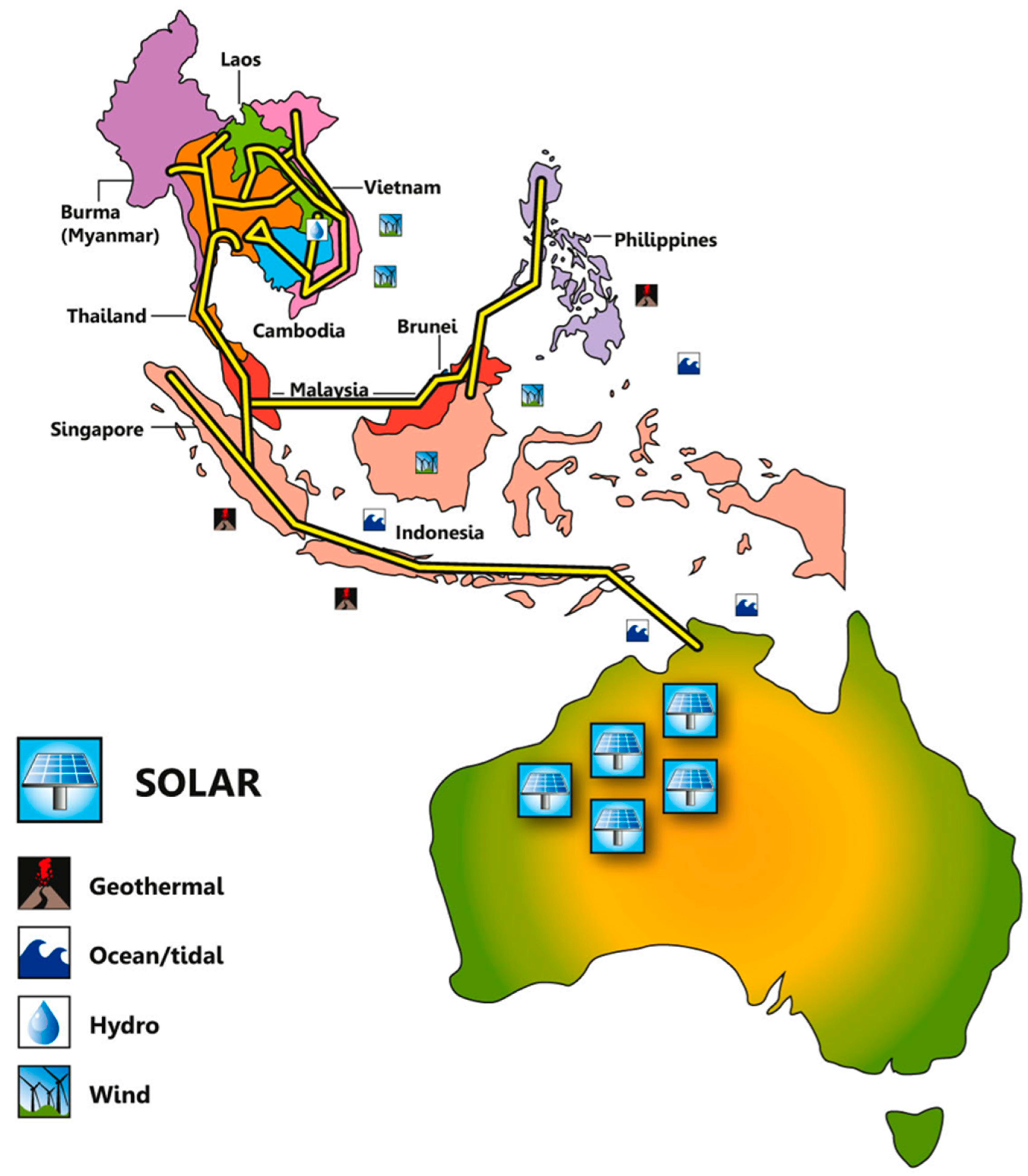
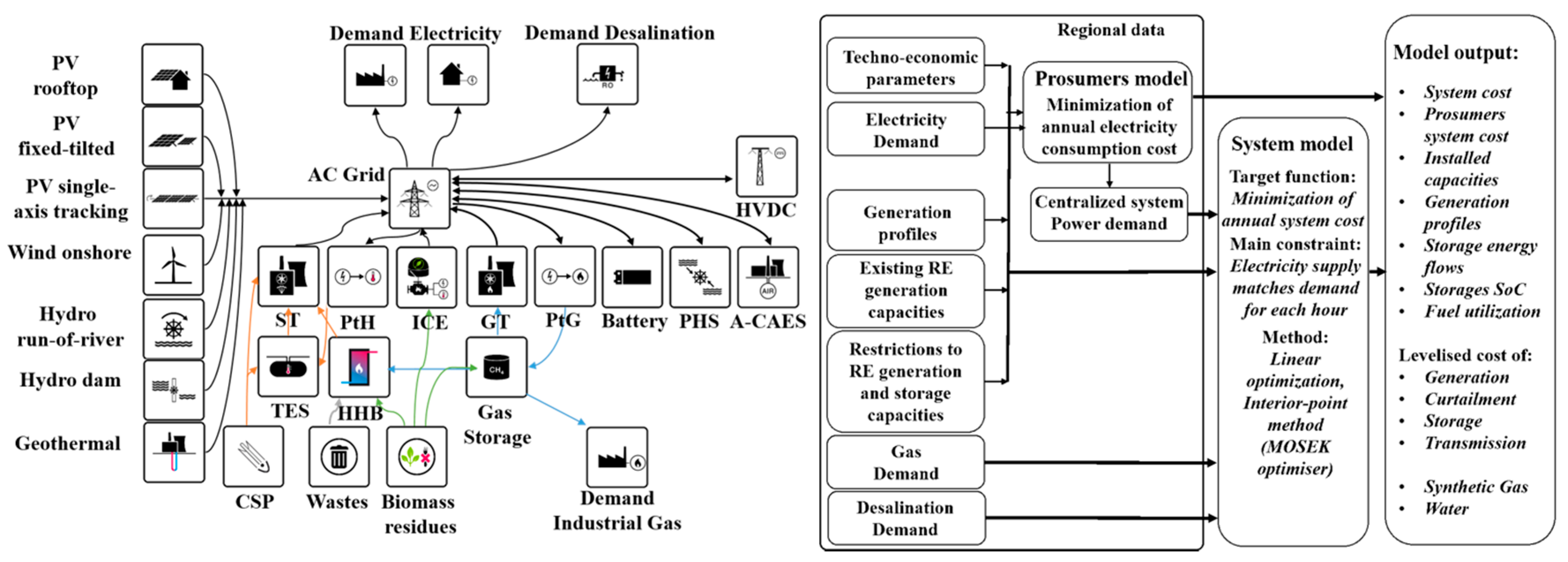
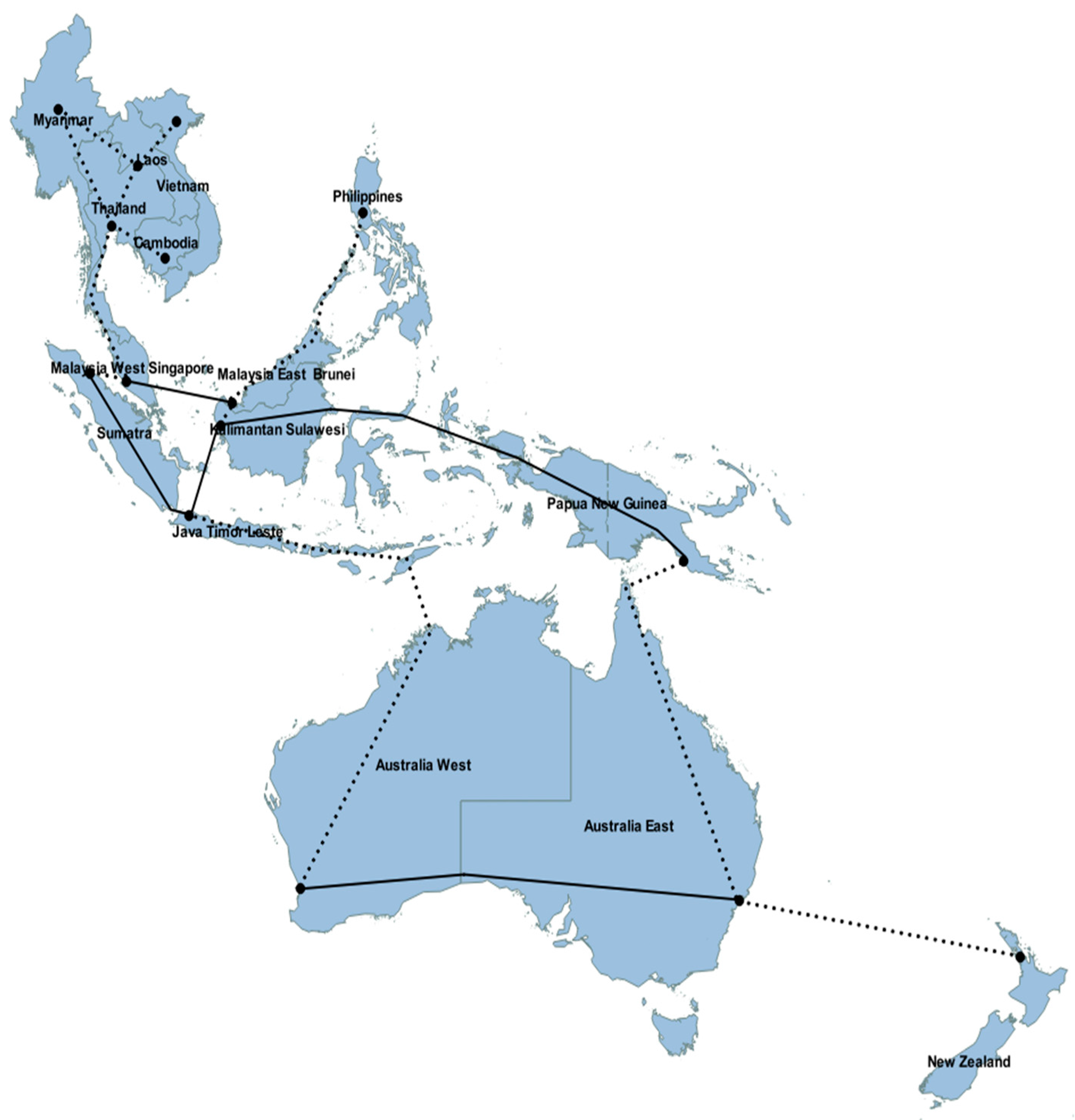
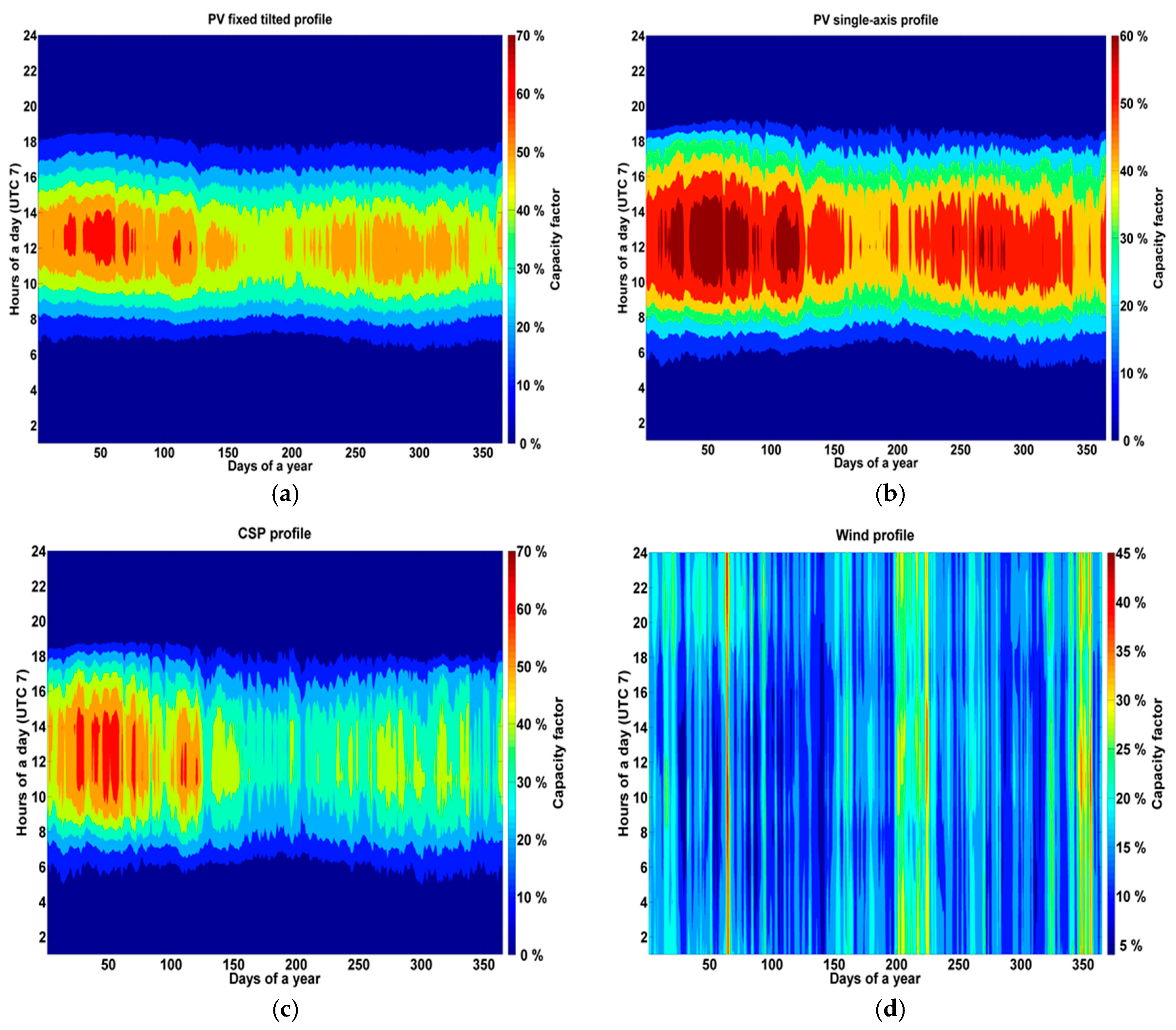
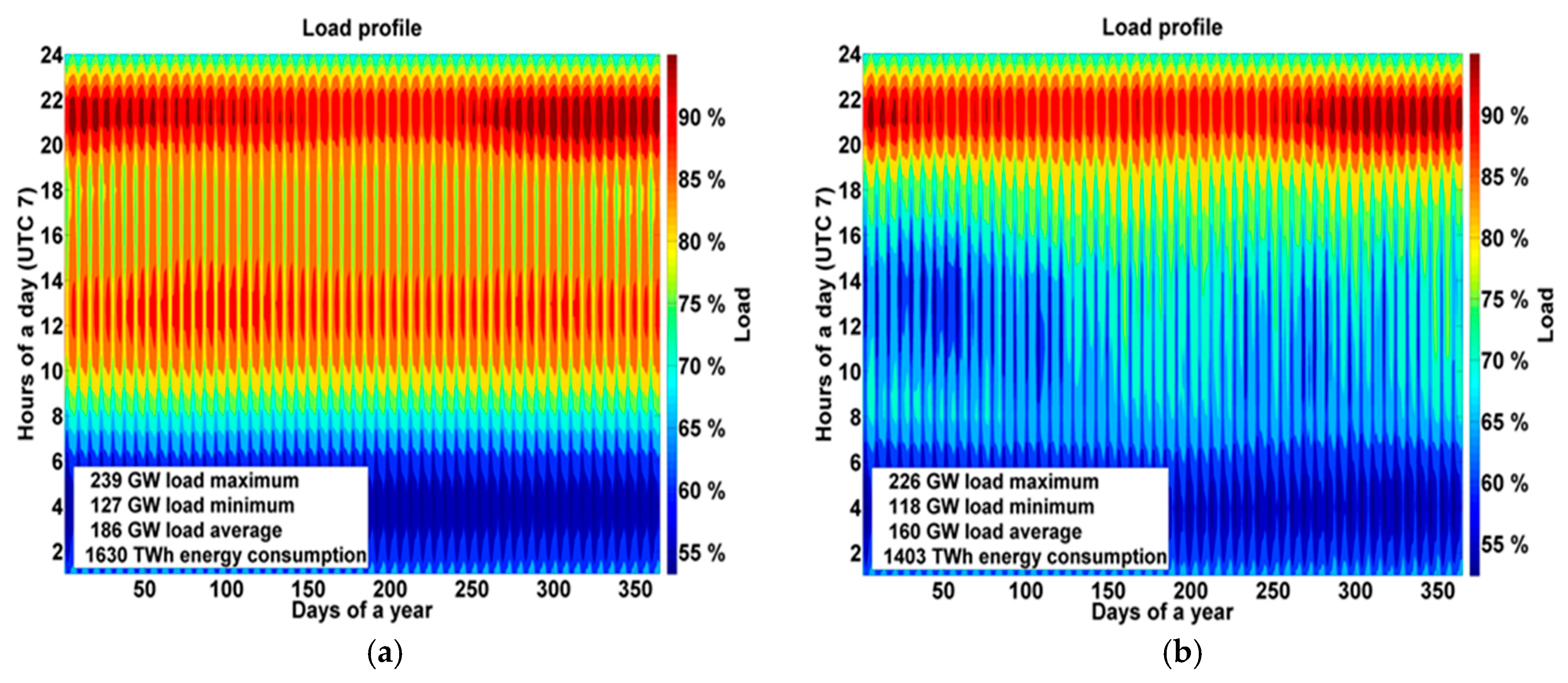
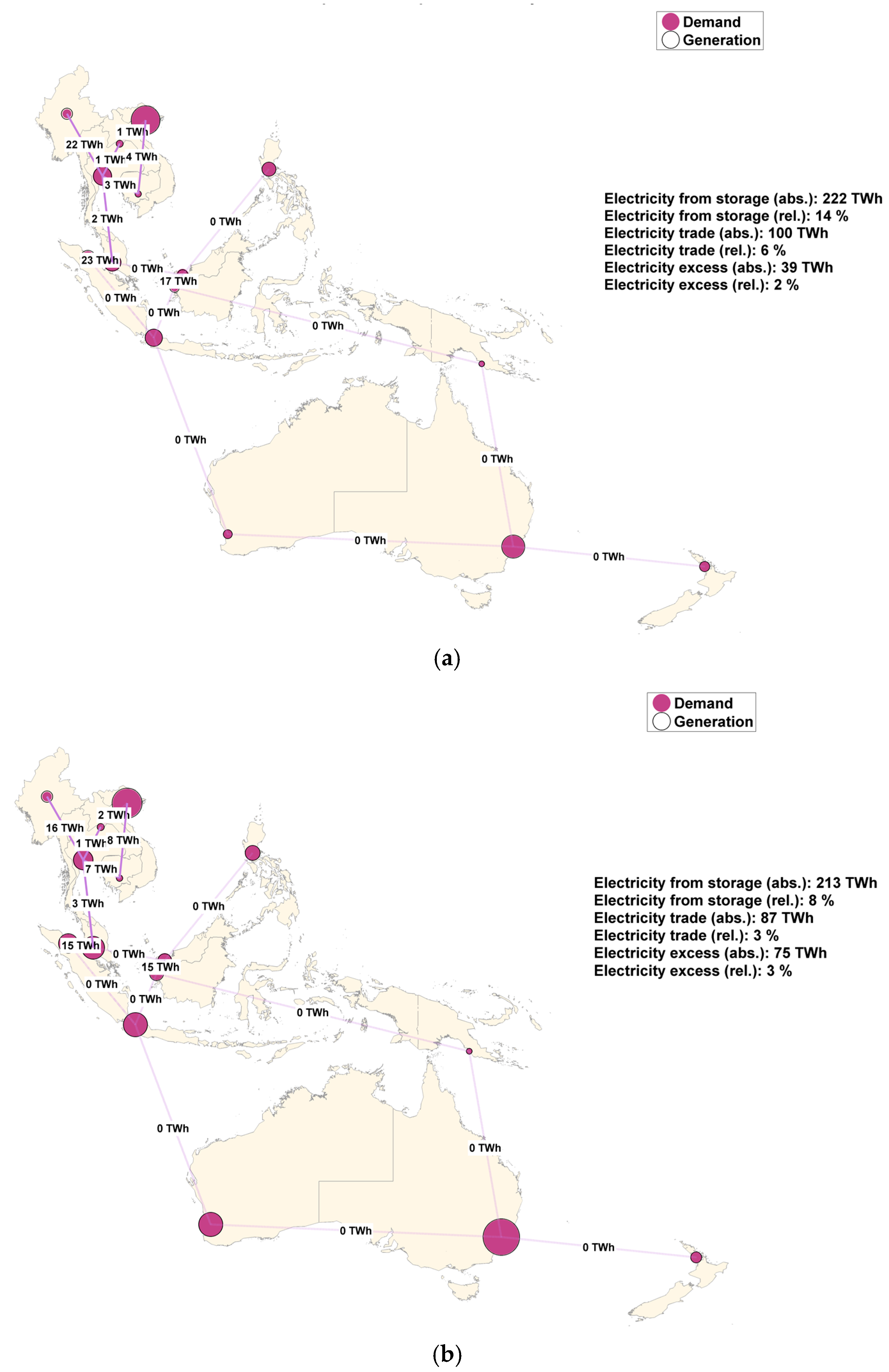
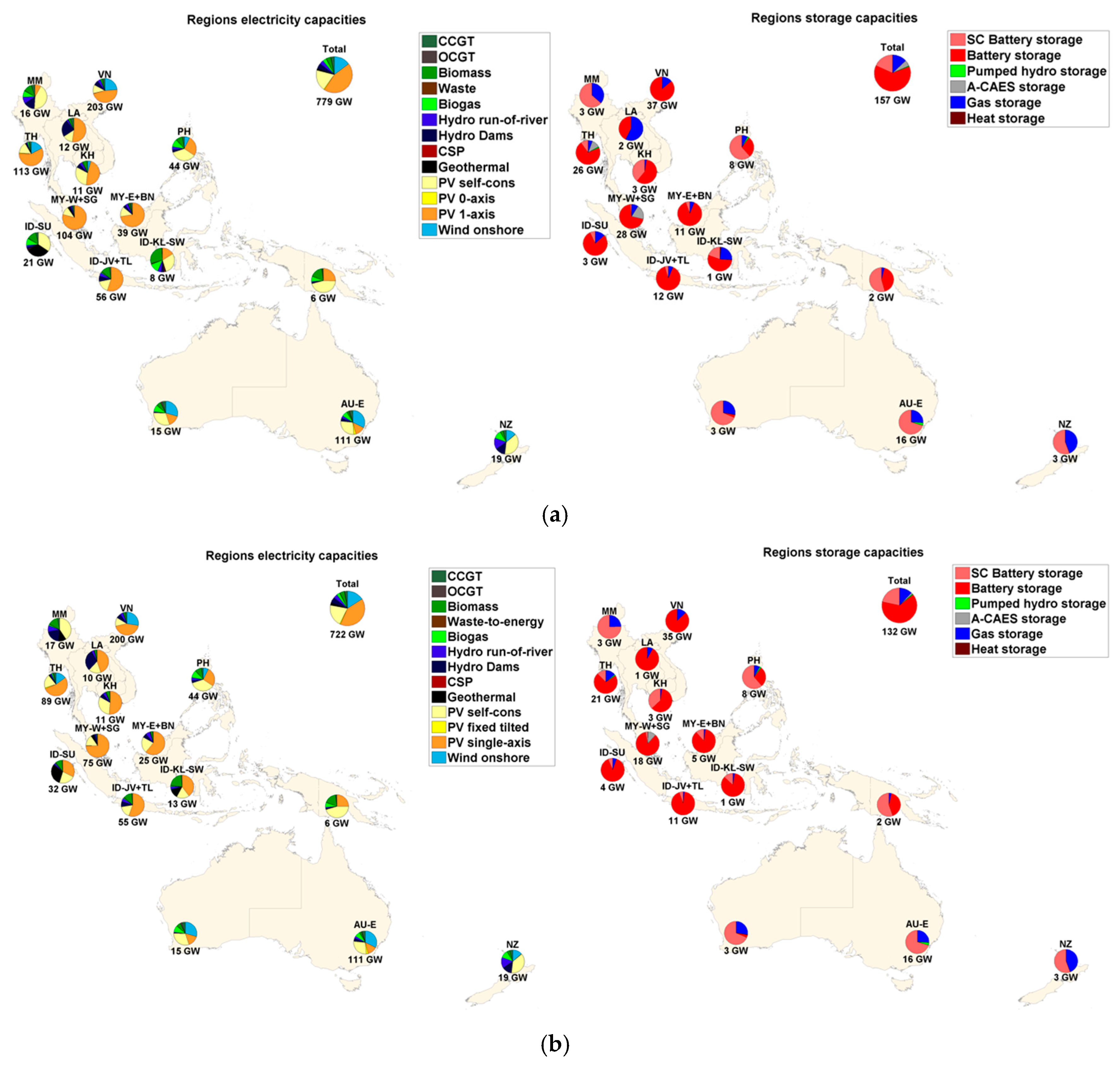
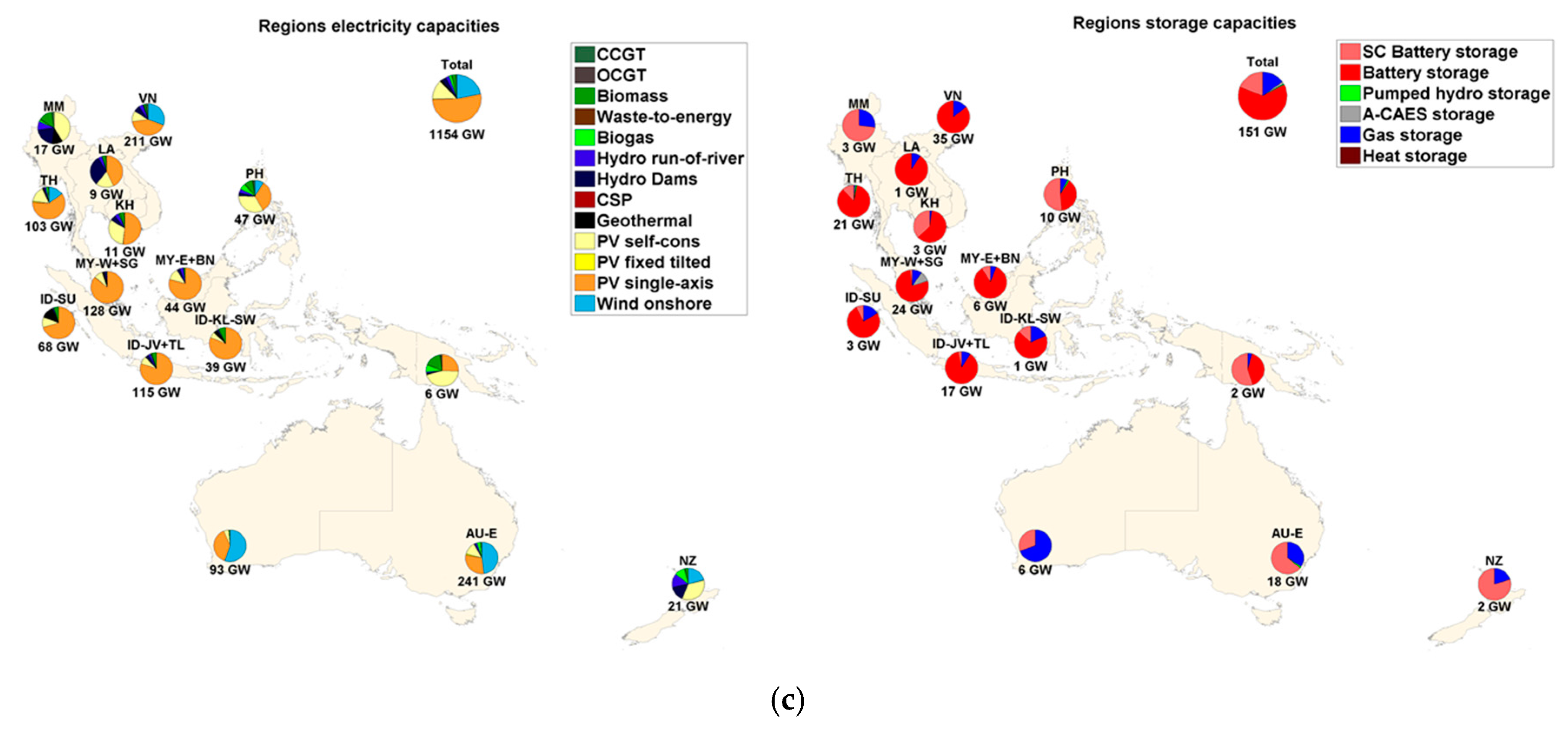
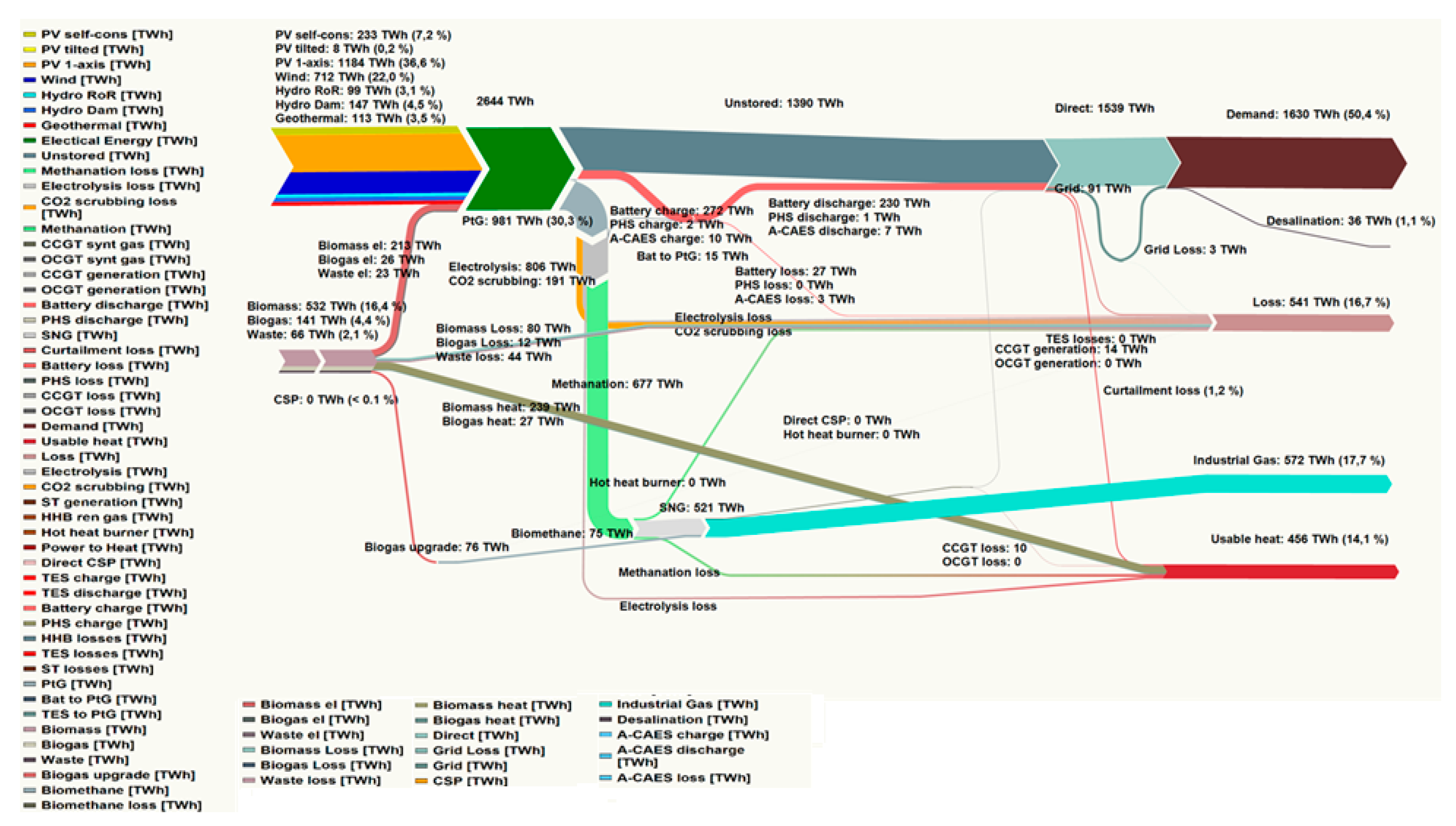
| Study | Scope | Key Findings |
|---|---|---|
| Elliston et al., 2012 [19] | Australia (NEM region) | 100% RE system technically feasible based on available RE resources for the year 2012. CSP and PV to satisfy about half of the total annual electricity demand |
| Matthew and Patrick, 2010 [20] | Australia | Wind and CSP with heat storage provide the least cost effective combination that is commercially available and can be deployed on a large scale in Australia |
| Elliston et al., 2013 [21] | Australia (NEM region) | Least cost options for 100% RE supply in 2030, dominated by wind with smaller contributions from photovoltaics |
| Mason et al., 2010 [14] | New Zealand | 100% RE system based on 53–60% hydro, 22–25% wind, 12–14% geothermal, 0.2–0.3% gasification or PHS, 0.8–0.9% wood thermal and 0.2–0.3% biogas generation is possible replacing the current system of 32% fossil fueled thermal generation |
| Blakers et al., 2012 [6] | Southeast Asia and Australia | Transmission of solar electricity from Australia is cost competitive. Demand for electricity in Southeast Asia in 2050 would be satisfied by solar electricity from Australia and supplemented by locally produced electricity from renewable and conventional sources |
| Taggart et al., 2012 [22] | Asia: connecting Australia-Southeast Asia-China | Decrease in cost of electricity from interregional connections and decrease in regions total emission cost |
| Taggart, 2013 [13] | Asia: connecting Australia-Southeast Asia-China | Network of highly efficient HVDC lines connecting all countries in 2050. Introduction of carbon pricing |
| Hearps and Gilbert, 2015 [23] | includes all Asian countries except OECD Asia, China and India | Electricity mix for Southeast Asia in 2030, Solar PV (55%) in small grids and stand-alone systems and geothermal (20%) |
| Teske et al., 2011 [7] | ASEAN | The share of renewables in the electricity generation would be 60% by 2030 and 92% by 2050 |
| Huber et al., 2015 [24] | ASEAN | Cheapest options for electricity generation are hydro, biomass and geothermal. Interconnections between the countries are beneficial |
| Technology | Capex [€/kW] | Opex Fix [€/(kW∙a)] | Opex Var [€/kWh] | Lifetime [a] |
| PV optimally tilted | 550 | 8 | 0 | 35 |
| PV single-axis tracking | 620 | 9 | 0 | 35 |
| PV rooftop | 813 | 12 | 0 | 35 |
| Wind onshore | 1000 | 20 | 0 | 25 |
| CSP (solar field) | 528 | 11 | 0 | 25 |
| Hydro run-of-river | 2560 | 115.2 | 0.005 | 60 |
| Hydro dam | 1650 | 66 | 0.003 | 60 |
| Geothermal energy | 4860 | 87 | 0 | 30 |
| Water electrolysis | 380 | 13 | 0.0012 | 30 |
| Methanation | 234 | 5 | 0.0015 | 30 |
| CO2 scrubbing | 356 | 14 | 0.0013 | 30 |
| CCGT | 775 | 19.4 | 0.001 | 30 |
| OCGT | 475 | 14.25 | 0.001 | 30 |
| Steam turbine | 600 | 12 | 0 | 30 |
| Hot heat burner | 100 | 2 | 0 | 30 |
| Heating rod | 20 | 0.4 | 0.001 | 30 |
| Biomass CHP | 2500 | 175 | 0.001 | 30 |
| Biogas CHP | 370 | 14.8 | 0.001 | 30 |
| Waste incinerator | 5240 | 235.8 | 0.007 | 20 |
| Biogas digester | 680 | 27.2 | 0 | 20 |
| Biogas upgrade | 250 | 20 | 0 | 20 |
| Technology | Capex [€/kWh] | Opex Fix [€/(kWh∙a)] | Opex Var [€/kWh] | Lifetime [a] |
| Battery | 150 | 10 | 0.0002 | 10 |
| PHS | 70 | 11 | 0.0002 | 50 |
| A-CAES | 31 | 0.4 | 0.0012 | 40 |
| TES | 24 | 2 | 0 | 20 |
| Gas storage | 0.05 | 0.001 | 0 | 50 |
| Technology | Capex [€/(kWNTC∙km)] | Opex Fix [€/(kWNTC∙km∙a)] | Opex Var [€/kWhNTC] | Lifetime [a] |
| HVDC line on ground | 0.612 | 0.0075 | 0 | 50 |
| HVDC line submarine | 0.992 | 0.0010 | 0 | 50 |
| Technology | Capex [€/kWNTC] | Opex Fix [€/(kWNTC∙a)] | Opex Var [€/kWhNTC] | Lifetime [a] |
| HVDC converter pair | 180 | 1.8 | 0 | 50 |
| Technology | Capex [€/(m3∙a)] | Opex Fix [€/(m3 a)] | Opex Var [€/m3] | Lifetime [a] |
| Water desalination | 2.23 | 0.09 | 0 | 30 |
| Technology | Capex [€/(m3∙h∙km)] | Opex Fix [€/(m3∙h∙km∙a)] | Opex Var [€/m3∙h∙km] | Lifetime [a] |
| Horizontal pumping and pipes | 19.3 | 0.39 | 0 | 30 |
| Vertical pumping and pipes | 15.5 | 0.31 | 0 | 30 |
| Region | Pop. [mio. Pop] | Electr. Demand [TWh] | PV-Single-Axis FLH | PV Optimally Tilted FLH | CSP FLH | Wind FLH | PV Single-Axis LCOE [€/MWh] | PV Optimally Tilted LCOE [€/MWh] | CSP LCOE [€/MWh] | Wind LCOE [€/MWh] |
|---|---|---|---|---|---|---|---|---|---|---|
| Total area | 746 | 1630 | 1905 | 1529 | 1552 | 1565 | 30 | 33 | 79 | 142 |
| New Zealand | 5 | 54 | 1765 | 1430 | 1541 | 4122 | 32 | 35 | 76 | 26 |
| Australia East | 25 | 245 | 2316 | 1733 | 2261 | 3500 | 25 | 29 | 52 | 30 |
| Australia West | 4 | 38 | 2397 | 1764 | 2424 | 3782 | 24 | 29 | 48 | 28 |
| Indonesia Papua + Papua New Guinea | 12 | 16 | 1816 | 1465 | 1300 | 1182 | 31 | 34 | 90 | 90 |
| Sumatra | 58 | 100 | 1746 | 1445 | 1193 | 440 | 33 | 35 | 98 | 240 |
| Java + Timor-Leste | 166 | 148 | 2203 | 1683 | 2008 | 1225 | 26 | 30 | 58 | 86 |
| Indonesia East | 37 | 32 | 1869 | 1503 | 1467 | 394 | 30 | 34 | 80 | 269 |
| Malaysia West + Singapore | 34 | 169 | 1835 | 1485 | 1298 | 454 | 31 | 34 | 90 | 233 |
| Malaysia East + Brunei | 9 | 72 | 1810 | 1489 | 1373 | 170 | 31 | 34 | 85 | 623 |
| Philippines | 138 | 98 | 1929 | 1503 | 1585 | 1799 | 29 | 34 | 74 | 59 |
| Myanmar | 59 | 40 | 1843 | 1539 | 1591 | 847 | 31 | 33 | 74 | 125 |
| Thailand | 69 | 184 | 1794 | 1495 | 1360 | 1559 | 32 | 34 | 86 | 68 |
| Laos | 9 | 26 | 1677 | 1439 | 1248 | 934 | 34 | 35 | 94 | 113 |
| Vietnam | 102 | 385 | 1764 | 1456 | 1287 | 1838 | 32 | 35 | 91 | 58 |
| Cambodia | 19 | 21 | 1810 | 1512 | 1340 | 1230 | 31 | 33 | 87 | 86 |
| 2030 Scenarios | Total LCOE | LCOE Primary | LCOC | LCOS | LCOT | Total Ann. Cost | Total CAPEX | RE Capacities | Generated Electricity |
|---|---|---|---|---|---|---|---|---|---|
| €/MWh | €/MWh | €/MWh | €/MWh | €/MWh | b€ | b€ | GW | TWh | |
| Region-wide | 66.7 | 44.4 | 1.9 | 20.4 | 0.0 | 109 | 919 | 763 | 1780 |
| Country-wide | 66.2 | 44.3 | 1.8 | 19.9 | 0.2 | 108 | 914 | 755 | 1773 |
| Area-wide | 63.5 | 45.6 | 1.1 | 15.8 | 1.0 | 104 | 883 | 705 | 1714 |
| Integrated scenario | 51.1 | 39.1 | 1.0 | 10.5 | 0.5 | 153 | 1339 | 1151 | 2794 |
| Technology | Unit | Region-Wide | Country-Wide | Area-Wide | Integrated Scenario |
|---|---|---|---|---|---|
| PV self-consumption | (GW) | 150 | 150 | 150 | 150 |
| PV optimally tilted | (GW) | 5 | 5 | 5 | 5 |
| PV single-axis tracking | (GW) | 347 | 341 | 294 | 604 |
| PV total | (GW) | 502 | 495 | 448 | 758 |
| CSP | (GW) | 0 | 0 | 0 | 0 |
| Wind energy | (GW) | 115 | 115 | 115 | 255 |
| Biomass power plants | (GW) | 31 | 30 | 31 | 30 |
| MSW incinerator | (GW) | 3 | 3 | 3 | 3 |
| Biogas power plants | (GW) | 25 | 25 | 21 | 20 |
| Geothermal power | (GW) | 11 | 12 | 17 | 15 |
| Hydro Run-of-River | (GW) | 28 | 28 | 27 | 27 |
| Hydro dams | (GW) | 38 | 38 | 39 | 39 |
| Battery PV self-consumption | (GWh) | 172 | 172 | 172 | 172 |
| Battery System | (GWh) | 591 | 588 | 507 | 580 |
| Battery total | (GWh) | 763 | 759 | 678 | 752 |
| PHS | (GWh) | 9 | 9 | 9 | 6 |
| A-CAES | (GWh) | 847 | 780 | 205 | 269 |
| Heat storage | (GWh) | 0 | 0 | 0 | 0 |
| PtG electrolyzers | (GWel) | 11 | 10 | 4 | 118 |
| CCGT | (GW) | 24 | 23 | 18 | 8 |
| OCGT | (GW) | 2 | 2 | 2 | 0 |
| Steam Turbine | (GW) | 0 | 0 | 0 | 0 |
© 2017 by the authors. Licensee MDPI, Basel, Switzerland. This article is an open access article distributed under the terms and conditions of the Creative Commons Attribution (CC BY) license (http://creativecommons.org/licenses/by/4.0/).
Share and Cite
Gulagi, A.; Bogdanov, D.; Breyer, C. A Cost Optimized Fully Sustainable Power System for Southeast Asia and the Pacific Rim. Energies 2017, 10, 583. https://doi.org/10.3390/en10050583
Gulagi A, Bogdanov D, Breyer C. A Cost Optimized Fully Sustainable Power System for Southeast Asia and the Pacific Rim. Energies. 2017; 10(5):583. https://doi.org/10.3390/en10050583
Chicago/Turabian StyleGulagi, Ashish, Dmitrii Bogdanov, and Christian Breyer. 2017. "A Cost Optimized Fully Sustainable Power System for Southeast Asia and the Pacific Rim" Energies 10, no. 5: 583. https://doi.org/10.3390/en10050583
APA StyleGulagi, A., Bogdanov, D., & Breyer, C. (2017). A Cost Optimized Fully Sustainable Power System for Southeast Asia and the Pacific Rim. Energies, 10(5), 583. https://doi.org/10.3390/en10050583







